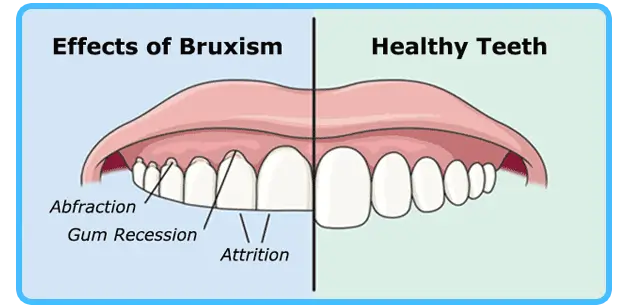How Bruxism (Teeth Grinding) Affects Oral Health
Introduction
Bruxism, commonly known as teeth grinding, is an involuntary habit that can have severe consequences for oral health. This condition often occurs during sleep or periods of high stress, leading to worn enamel, cracked teeth, and even jaw pain. In this article, we will explore the causes of bruxism, its effects on dental structures, and the various treatment options available to alleviate the condition and protect oral health at FDental Center


Understanding Bruxism and Its Causes
1. What is Bruxism?
Bruxism is defined as the habitual grinding or clenching of teeth. It can occur during both wakefulness and sleep, with sleep bruxism being particularly problematic because it happens unconsciously and often goes undiagnosed.
2. Contributing Factors
Psychological Stress and Anxiety
High levels of stress and anxiety are among the primary triggers of bruxism. Emotional tension can manifest physically through the clenching and grinding of teeth.
Sleep Disorders
Conditions such as sleep apnea or irregular sleep patterns are commonly associated with bruxism. Disruptions in sleep can exacerbate the frequency and intensity of teeth grinding.
Genetic Predisposition
Research suggests that some individuals may be genetically predisposed to develop bruxism, making them more vulnerable to its effects regardless of external factors.
Effects of Bruxism on Oral Health
1. Enamel Wear and Tooth Sensitivity
The repeated grinding action causes significant wear on the enamel, which is the protective outer layer of the tooth. As enamel diminishes, the underlying dentin becomes exposed, leading to increased sensitivity to hot, cold, or sweet stimuli.
2. Cracks and Fractures in Teeth
Chronic bruxism can result in small cracks or even fractures in the teeth. These structural damages not only compromise the integrity of the tooth but may also pave the way for further decay and infection.
3. Jaw Pain and Temporomandibular Joint (TMJ) Disorders
Excessive clenching and grinding place undue stress on the jaw muscles and the temporomandibular joint, leading to pain, headaches, and sometimes dysfunction of the jaw joint itself.
4. Aesthetic Concerns
The wear and tear caused by bruxism can alter the appearance of teeth, affecting both their color and shape. This can have a negative impact on a person’s self-esteem and overall smile.
Diagnostic Methods for Bruxism
1. Clinical Examination
Dentists conduct a thorough clinical examination to identify signs of enamel wear, cracks, or fractures. This assessment is critical for diagnosing the severity of bruxism.
2. Radiographic Imaging
X-rays and other imaging tools can help evaluate the extent of damage to the teeth and jaw joint. These images provide valuable insights that inform the treatment plan.
3. Patient History and Stress Assessment
Understanding the patient’s lifestyle, stress levels, and sleep patterns is crucial in diagnosing bruxism. This comprehensive approach ensures that both the symptoms and underlying causes are addressed.
Treatment Options for Bruxism
1. Night Guards
Wearing a custom-fitted night guard is one of the most effective ways to protect teeth from the damaging effects of grinding during sleep. These devices distribute the pressure evenly and reduce the risk of enamel wear.
2. Stress Management Techniques
Since stress is a significant contributor to bruxism, interventions such as counseling, cognitive-behavioral therapy, and relaxation techniques (e.g., yoga and meditation) can help reduce the frequency of teeth grinding.
3. Dental Restorative Procedures
For patients who have already experienced significant tooth damage, restorative procedures such as fillings, crowns, or bonding may be necessary to repair and protect the teeth.
4. Behavioral Therapy
In some cases, behavioral therapy aimed at making the patient aware of their grinding habit during the day can help reduce the incidence of bruxism.
Daily Preventive Measures
1. Maintaining Excellent Oral Hygiene
Regular brushing and flossing not only maintain overall oral health but also reduce sensitivity caused by enamel wear. Using a soft-bristled toothbrush can help minimize additional abrasion.
2. Reducing Stress
Adopting stress-reducing habits—such as engaging in regular physical activity, ensuring adequate sleep, and practicing mindfulness—can help lower the risk of bruxism.
3. Regular Dental Check-Ups
Consistent follow-up visits to the dentist are essential for monitoring any changes in tooth structure and for adjusting treatment plans as necessary.
Challenges and Future Directions
1. Innovations in Protective Devices
Research is ongoing into developing more comfortable and effective night guards that patients can wear consistently without compromising their sleep quality.
2. Advanced Therapeutic Approaches
Future treatments may include new medications or therapies that specifically target the neural pathways involved in bruxism, offering a more direct approach to preventing the habit.
Conclusion
Bruxism is a significant oral health issue that, if left untreated, can lead to severe dental damage and chronic pain. Early diagnosis and intervention are key to mitigating its effects. With the right combination of protective devices, stress management, and restorative treatments, patients can minimize the impact of bruxism and maintain both the health and appearance of their teeth. Ongoing research and technological advances promise even more effective solutions in the future, ensuring that those affected by bruxism can enjoy a better quality of life.
